This weekend was one of the best weekends I have ever had in my entire life. It was amazing.
On Thursday night, I went over to the “Beach Party,” which was fine. I met a bunch of new people, including a couple of other Harvard folks, a few South Africans, some Frenchies, some Aussies, Brits. Putt-putt golf, barbecue, beer, dancing. It was fun, but I left feeling extremely frustrated at my overwhelmingly expatriate life here. I feel like I live in bubble-world, observing from car windows, never really touching the people or the culture. I move from my American household to the backseat of a car where I am driven to my expatriate-laden work environment. When I go out, I go out with other expats. I am so tired of it! The weekend was exactly what I needed.
We left on Friday at around 9am, and drove for three and a half hours to the Panjshir Valley. I have never seen a more beautiful place. The drive was full of interesting sights as well. On the way out of Kabul, the air starts clearing and the concrete subsides into grass and mountains and so many tiny communities, seemingly in the middle of nowhere, of new and rebuilt mud-brick square dwellings mixed among the remnants of houses destroyed by 23 years of war. Here and there are old military tanks, artillery forts, graves marked with green flags. You know by the red and white rocks that there is a “sidewalk” that has been cleared of mines (the white half of the rock) adjacent to a field still full of active landmines (the red half of the rock). Children still play in the fields, and women and men still work in the fields. Way up in the mountains, you can see the zig-zag of switchback roads that lead to small communities.
We passed through a couple of really cute towns on the way. I was so pleased that when we got out at the first bazaar to buy refreshments, the children were so excited to pose with me in photos. Actually, even a couple of the adults were excited to pose with me!
The kids in the bazaar.









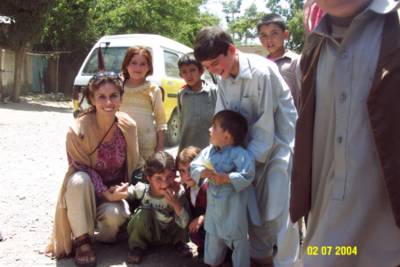

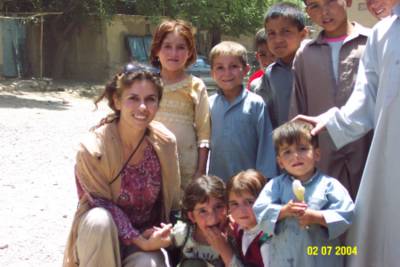



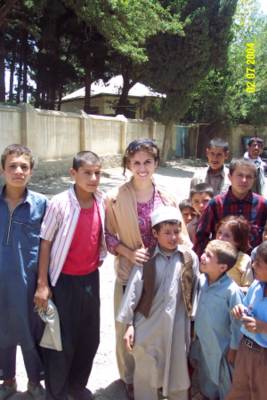
I have to say, the Afghan people must be among the most consistently beautiful people I’ve ever seen. It is rare to see an Afghan who is not striking. So many cultures and ethnicities converge in this place – I’ve been told by several Afghans that I look like I belong, which I find extremely flattering! A few people have even mistaken me for an Afghan. Light eyes and blonde streaks and all. Even my round features seem to be consistent with some of the various ethnicities here.
Once we reach the Panjshir Valley, it is still a six hour drive before you get to the other end. We only drove for another 2 hours in. The Panjshir is an oasis in this desert country. The river flows down through the valley, and you can see where the water stops diffusing out beyond the shores – dry, sandy soil meets green vegetation in a clearly demarcated boundary. Kind of strange, really. The mountains are huge and beautiful, and the mountain road tiny and treacherous for anyone who is not a native Panjshiri. All of the drivers who work for MSH are, fortunately, Panjshiris. And, as I mentioned in the preview last time, there are tens of abandoned soviet and Taliban tanks throughout the valley.

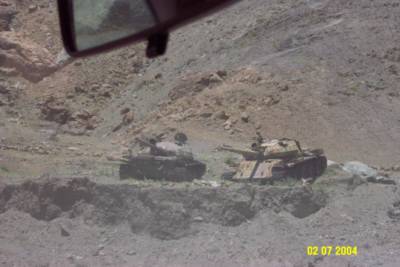
At one point along the road, there is a huge live munitions stockpile, and a cave full of weapons, just in case another force should try once again to take the Valley. And all along the way, there are mountain villages. How do these people get in and out? Where do they get their food? How do they build these lovely homes? How do they get their work animals in? And a question always on my mind when I see isolated communities, where do they go for health care when they need it? Amazing.
We stopped along the way to visit Massoud’s shrine. Massoud is adored here more than any other figure. He was a very well-respected fighter for the freedom of the Afghan people. He was a great general. He was assassinated during the Taliban times. His shrine is on a hill that looks over great valleys and mountains on either side. People make pilgrimages here.
Massoud's memorial.



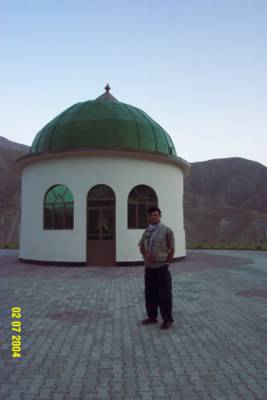


We stopped on the way at a minister’s home to picnic along the river. What a decadent experience! Two large Afghan carpets were laid out under a 300 year-old tree, right on the bank of the river.




We lounged on pillows and were served sweets, tea, beer, bread, and really awesome fresh-off-the-grill, fresh-killed kebab. You should see the skewers they use! Huge metal lances – nothing like our little sticks. Oh, amazing. And fresh melon, and berries. Wonderful. Here I am contributing to the preparation of the kebab:

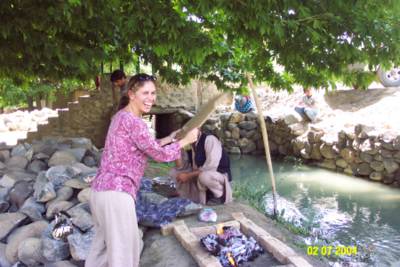
I played with the children – chased them around, took their photos – I think people were surprised to see an adult woman doing these things, but I asked beforehand, so I know no one was offended.

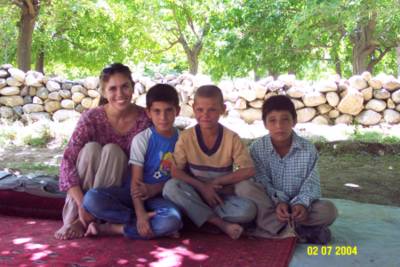

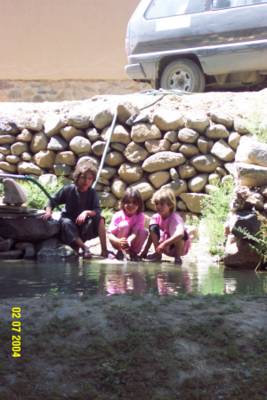
After some more lounging and napping,


we set out for our next destination, farther into the valley.

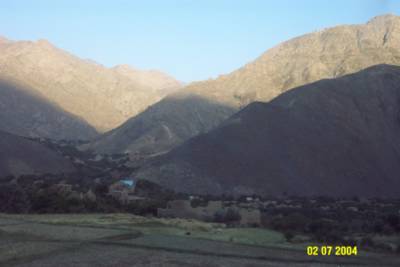



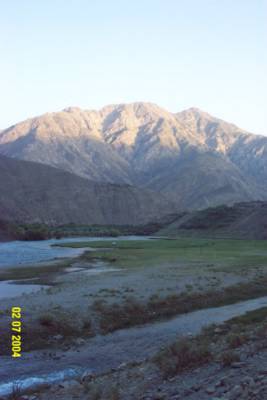
Two of our security officers are from the area, and are extremely well-respected. People along the way would stop to salute them. Baba Jan and Assad were instrumental in the wars against the Soviets and the Taliban. They were brilliant tacticians, and hard-core fighters, apparently. They know and have traversed all the best paths over the mountains. This is their land, and they have fought to protect the land and their people.
Assad was our host at the next two stopping points. First we stopped at one of his uncles’ house, where we ate dinner and slept outside right on the banks of the raging river. More palaw (the rice dish), kebab, lamb stew, salad, fresh naan, a traditional okra dish, beer, yoghurt, berries, peaches, apricots. Such amazing food. And sitting around talking with the local people, listening to them sing, laughing together, eating together, resting together. Wonderful. I slept peacefully with the sound of the river rushing by.
In the morning we awoke early to head to our next destination, another uncle’s house farther into the valley. Here we had fried bread stuffed with cheese, dipped in home-made fresh fruit jams (mulberry and apricot), warm milk with chai, fresh yogurt. More relaxing on pillows under trees, then up the road (that Assad’s uncle built) high up into the mountains. What an awesome vista!



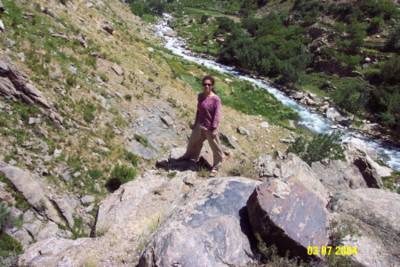
It was exactly what I needed – to be outside, breathing fresh air, meditating on such spectacular beauty, climbing among the rocks. Cristi and I swam in the icy-cold water (I swear it must have been 33 degrees) – it was actually a bit painful. And, I guess to be exact, we didn't really swim. We dove in and swam out as soon as we could. We were very pleased with ourselves because many of the men were afraid to dive in as we did and as women it was assumed we would not dare to brave the currents of that ice water. We ate fresh yogurt (“very fresh--it’s from that cow over there”) and fresh cherries from the trees. We laid out on the rocks in the sun. We lounged on pillows under trees.
Then, back again for lunch of more kebab, traditional okra specialty, naan, salad, fresh fruit, boneless lamb. More stories from our impressive hosts. More lounging. Picking some mulberries fresh from the trees. I didn’t want to come back to Kabul.

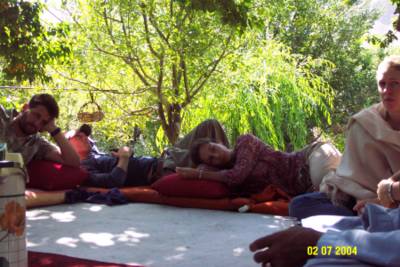
It was so great. So great to be among the Afghan people, great to eat traditional, home-cooked foods, great to be in such a beautiful place. Ahhhhhhh. I was very happy. Two of the best days I’ve ever had.
Now I am back at work, trying to keep things going. I am very hopeful about the project and looking forward to it!
I will post some photos of the weekend soon. And I will be in touch again with more news when I have more to share.
Love and hugs.




























